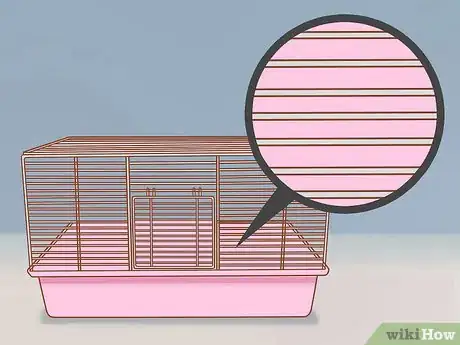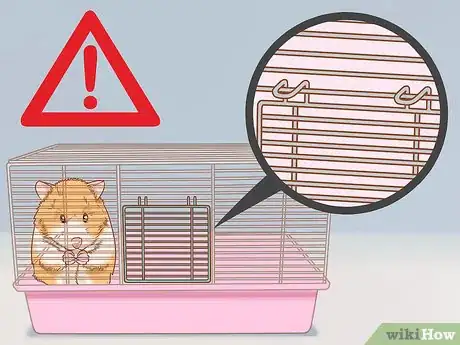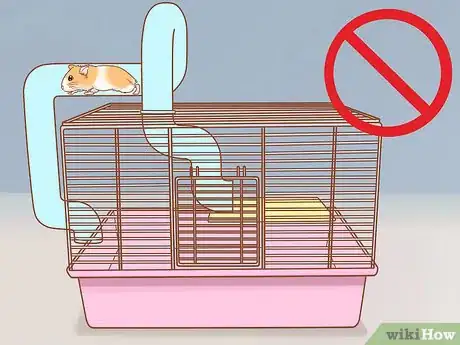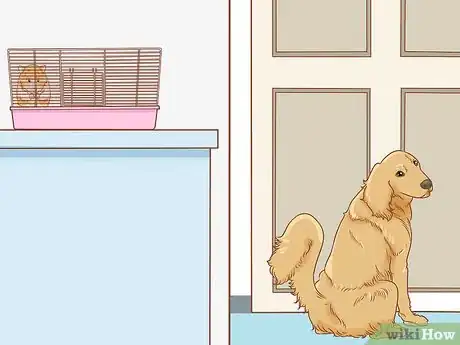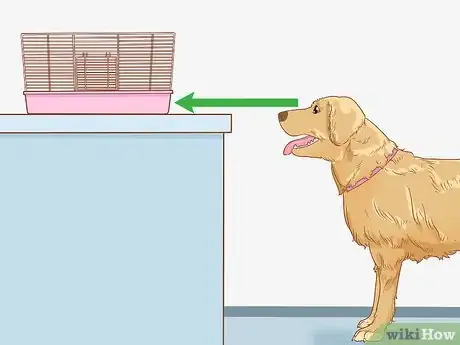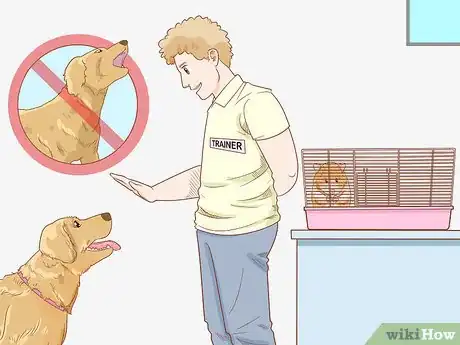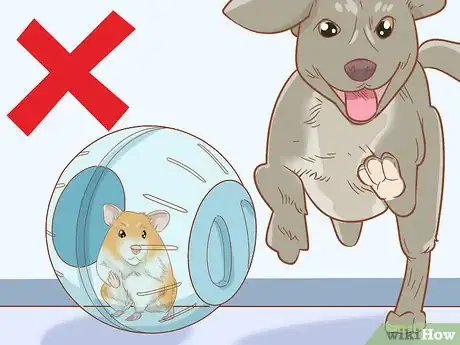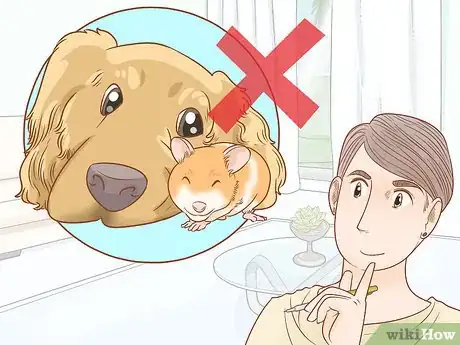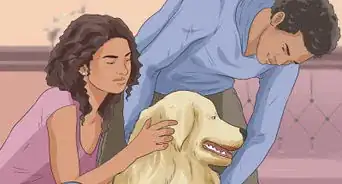This article was co-authored by Deanne Pawlisch, CVT, MA. Deanne Pawlisch is a Certified Veterinary Technician, who does corporate training for veterinary practices and has taught at the NAVTA-approved Veterinary Assistant Program at the Harper College in Illinois and in 2011 was elected to the board of the Veterinary Emergency and Critical Care Foundation. Deanne has been a Board Member of the Veterinary Emergency and Critical Care Foundation in San Antonio, Texas since 2011. She holds a BS in Anthropology from Loyola University and an MA in Anthropology from Northern Illinois University.
There are 10 references cited in this article, which can be found at the bottom of the page.
This article has been viewed 55,754 times.
If you have a dog and a hamster in the same house, you may be worried about how to keep your smaller furry friend safe from your larger one. Put your worry aside! While it’s important to keep dogs and hamsters separated, that doesn’t mean you can’t keep both. As long as you choose a good cage and follow some basic safety rules, your two pets can coexist in your home in harmony.
Steps
Choosing the Safest Cage
-
1Pick a glass cage. Unlike wire cages, glass tanks don’t have little openings that your dog could reach through. They’ll also hold up against hamster chewing, so your furry friend will be less likely to escape and find itself in danger. When using a glass tank, be aware of the following:[1]
- These tanks heat up quickly. Keep them far away from heating vents and direct sunlight. Buy a hamster-safe thermometer to make sure the temperature doesn’t rise more than a degree or two above 75℉ (24℃). The ideal range is 65-75℉ (18-24℃).[2]
- Glass tanks can also lead to a quicker buildup of ammonia, which could cause respiratory problems for your hamster. Remove wet bedding daily and clean the cage weekly.
-
2Check on the bar spacing if you pick a wire cage. If you do go for a wire cage, it’s important that you measure the spaces between the bars. Never buy a cage with more than 0.5-inch (1.27-cm) spaces. Bigger spaces might allow your hamster to squeeze out or your dog to get its paws in.[3]
- Wire cages may be a better option if you live in a hot climate or are worried about cleaning the cage consistently.
Advertisement -
3Choose the right cage size. If your hamster has a comfortable and large space to live in, it’ll be less likely to try to escape. Pick a 10-gallon (about 40 L) tank if you get a glass aquarium. Go for a 12 inches high, 12 inches wide, and 18 inches long (30.48 x 30.48 x 45.72 cm) wire cage.[4]
-
4Buy high-quality bedding made of plant fibers. This option will keep your hamster’s cage cleaner and more odor-free. If you don’t want to spring for the cellulose bedding, choose aspen shavings. Check bedding daily to remove wet spots and clean it out completely once per week.
-
5Keep your hamster entertained with toys and accessories. Entertaining your hamster will also keep it from wanting to escape. Provide it with a solid-floored exercise wheel and a few chew toys. It also needs a nesting box to nap in. Some ladders or ramps will add variety to its day.
-
6Secure and test the cage openings. It’s especially important for hamster owners with dogs to be careful about cage doors. Before you buy a cage, make sure the door is easy to close and lock. Each time you open and close the cage door at home, double check that it’s completely secure before walking away from your hamster.[5]
-
7Avoid using tunnel attachments on your hamster’s cage. While these tunnels can be a fun way for hamsters to play and get exercise, they’re not great for owners who also have a dog. The tunnels are much less secure and sturdy than a tank or cage. Since your dog could easily break into the tunnels, don’t give them that chance.[6]
- Instead, provide tunnels inside the cage.
Providing a Safe Environment
-
1Keep your hamster isolated from your dog. If you can, keep these two pets completely separated at all times. This will include keeping the hamster cage in an area where you dog cannot reach it. Ideally, your dog shouldn't even see it. Providing different environments for your furry friends is the best way to keep them safe and happy.[7] Since your dog will likely hang out in living rooms and dens, consider keeping your hamster in a home office or spare bedroom.
- Because your hamster will be away from the family’s main action in these rooms, hang out with your hamster in its private area for at least an hour a day.
- Hamsters are crepuscular, so they will move around in the late evening and dawn hours. This noise could disturb your dog, so keep the hamster in a separate area from where your dog will sleep or rest.
-
2Place the cage above your dog’s eye level. Even if you keep your hamster cage in a space where your dog isn’t allowed, don’t keep the habitat on the floor. This will help protect your hamster if your dog ever gets into the hamster’s room.[8] Use a sturdy table, bookshelf, or desk to elevate the cage.[9]
- If you can’t completely separate your hamster and dog, it’s especially important that the cage be up high. Try to put the cage higher than your dog could reach with its paws.
-
3Train your dog not to bark near your hamster. Hamsters have an excellent sense of hearing. Dog barks can be startling and extremely stressful for your hamster. While a barking dog won’t be as big a problem if you can give your hamster its own room, you should still try to limit your dog’s barking.[10]
- Never punish or shout at your dog when they’re barking. Instead, reward them when they’re being quiet. You can also figure out what makes your dog bark and avoid exposing them to the source of the problem.[11]
-
4Monitor small children and make sure they know your pets’ rules. Having multiple pets with small kids can be a great way to teach responsibility. However, it’s important that children understand that your hamster could be hurt by your dog if it escaped. Provide them with clear rules, including:
- Don’t open the hamster cage without the help of a parent or another adult.
- Keep the hamster cage securely closed if your dog is nearby.
- Never handle your hamster or let it out to play unless the door to its room is closed.
- These guidelines are especially important to emphasize to children aged about eight and younger.
-
5Don’t let your dog chase the exercise ball. Your hamster will love being in its exercise ball for about 15-20 minutes once per day. Only transfer your hamster to and from the exercise ball in a closed room. Once it’s in there, keep your dog away from your running hamster. You don’t want exercise time to turn into a disaster!
- Let your dog outside or keep it in a different room during this time. This will allow your hamster to visit other parts of the house outside of its room.
- Keep the exercise ball away from ledges or steps. It’s also safer to keep the ball on carpeted flooring, if possible.
-
6Don’t expect an unlikely animal friendship. As cute as you may think it would be for your dog and hamster to be friends, it’s extremely unlikely that would ever happen. Hamsters are natural prey animals, and dogs are not. Don’t introduce these two pets on the off chance that they’ll get along.[12]
- It’s much more likely that your hamster will get hurt if you try to encourage a friendship between your dog and your hamster.
Expert Q&A
Did you know you can get expert answers for this article?
Unlock expert answers by supporting wikiHow
-
QuestionI have two dogs but they stay outside, is it still safe? Also, whenever my dogs bark I can clearly hear them, but for some reason my hamster can't hear them and can ignore them very well, how is he doing this?
 Deanne Pawlisch, CVT, MADeanne Pawlisch is a Certified Veterinary Technician, who does corporate training for veterinary practices and has taught at the NAVTA-approved Veterinary Assistant Program at the Harper College in Illinois and in 2011 was elected to the board of the Veterinary Emergency and Critical Care Foundation. Deanne has been a Board Member of the Veterinary Emergency and Critical Care Foundation in San Antonio, Texas since 2011. She holds a BS in Anthropology from Loyola University and an MA in Anthropology from Northern Illinois University.
Deanne Pawlisch, CVT, MADeanne Pawlisch is a Certified Veterinary Technician, who does corporate training for veterinary practices and has taught at the NAVTA-approved Veterinary Assistant Program at the Harper College in Illinois and in 2011 was elected to the board of the Veterinary Emergency and Critical Care Foundation. Deanne has been a Board Member of the Veterinary Emergency and Critical Care Foundation in San Antonio, Texas since 2011. She holds a BS in Anthropology from Loyola University and an MA in Anthropology from Northern Illinois University.
Certified Veterinary Technician
References
- ↑ http://animals.mom.me/should-hamsters-live-tank-cage-4180.html
- ↑ http://animals.mom.me/temperatures-can-hamsters-live-1443.html
- ↑ http://animals.mom.me/should-hamsters-live-tank-cage-4180.html
- ↑ http://animals.mom.me/should-hamsters-live-tank-cage-4180.html
- ↑ https://www.youtube.com/watch?v=405ldMmqgIg&feature=youtu.be&t=123
- ↑ https://www.youtube.com/watch?v=405ldMmqgIg&feature=youtu.be&t=265
- ↑ https://www.purina.co.uk/dogs/getting-a-new-dog/welcoming-your-dog/introducing-your-dog-to-other-pets
- ↑ https://www.youtube.com/watch?v=405ldMmqgIg&feature=youtu.be&t=198
- ↑ https://www.omlet.co.uk/guide/hamsters/hamster_housing/cage_placement

